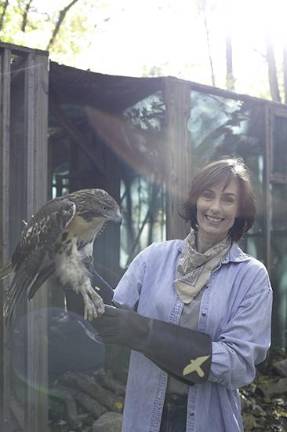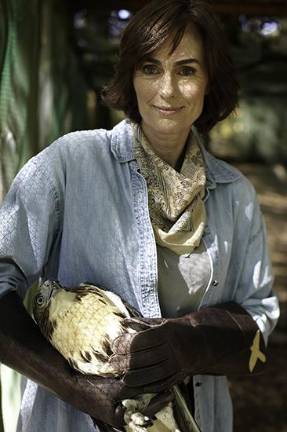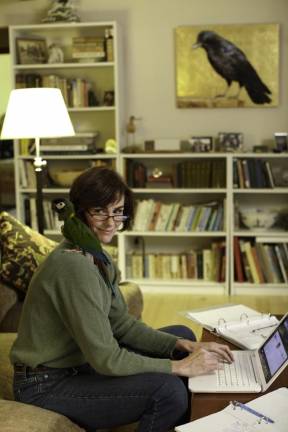One wild counterculture
In a bird whisperer’s debut novel, wildlife rehabbers band together to play hardball














Raptors and songbirds are Suzie Gilbert’s muse. From her early days writing a newsletter for the Hudson Valley Raptor Center; to her freelance environmental column (“they let me sort of rant about environmental atrocities”); to her hit memoir, Flyaway, about raising two kids while operating a home-based bird rescue; to her children’s book, Hawk Hill, wild birds have played the leading role.
But a novel? It had never crossed her mind until Gilbert shared a funny rehabber story with her book agent, and he said, that’d make a great novel. Why don’t you write one?
Because I don’t know how, she said. Her agent told her to read Carl Hiaasen, a journalist turned crime novel author whose madcap plots often feature environmental corruption. She did, and then decided: “I can write a novel. What hubris was that! It took me almost two and a half years. It took me four drafts – the idea was the same, trying to get an eagle to Canada on this underground railroad of rehabbers.”
The fourth try was the charm, at least after she’d edited it down by 100 pages, a sentence-by-sentence slog that improved the book but not Gilbert’s eyesight. The result is Unflappable, whose plot rips along as an orphaned 25-year-old bird fanatic shepherds a bald eagle to safety, evading her mega-rich control freak husband and law enforcement with help from her network of hard-drinking rehabber friends.
“They’re my peeps, they’re my tribe,” Gilbert said, of her real-life rehabber friends. “Honestly, they just work themselves so hard.” None of Gilbert’s characters are mirror images of real people – although friends have called her up to ask – but “there are bits of rehabbers in all of those rehabbers.”
There’s Luna, the heroine, whose billionaire husband tries to win her back by kidnapping the eagle she adores. There’s Esther the bat researcher, a widow who fights the lethal white-nose syndrome by day and at night hits the bourbon and sends insulting, expletive-laden emails. There’s Helene de la Croix, the iconic Canadian Bird Woman whose eagle sanctuary is the destination of Luna’s odyssey. And then there’s Warren, aka Panther Man, Luna’s heavily armed, ex-Navy SEAL guardian angel.
“I love Warren. He’s my guy,” laughed Gilbert. “What gets me about Warren is he is a military man and he’s trained and he’s really good at what he does, but when he feels it’s time to break the rules, he will do it. There’s not necessarily an outlaw mentality among rehabbers, it’s more that they just will do what it takes to save an animal.”
As Luna’s Thelma and Louise-style road trip brings her from rehabber to rehabber (she can only stop at places with a flight cage big enough for an eagle), readers get a close-up of a community that usually flies under the radar. We learn a little about each animal we encounter, but the big takeaway is an insight into what leads people into a line of work that is smelly, unprofitable and heartbreaking. Rehabbers “spent their lives fighting ignorance, indifference and greed, struggling to help those who had no voice,” wrote Gilbert. “It was clearly a one-sided battle.”
The novel is set in the present, and alludes to the fact that now is an especially depressing moment for rehabbers, as protections that environmentalists spent decades fighting for – like the ban on lead bullets, which can poison wildlife – get thrown out one after another. “Every single day there’s another environmental regulation that’s just being ripped to shreds,” said Gilbert. So why even bother?
Elias, a kindly grandfather who runs a sanctuary in Pennsylvania, gives us one version of an answer. Summoning his inner criminal to smuggle an eagle past the cops in a friend’s hearse, he fires himself up for the special op by thinking back over his little victories over the years. “He could take a wild creature on the brink of death, bring her back to life, and set her free. Not every time, of course. But when the magical, mystical, odds-defying sequence worked, it was enough to prevent him from laying down his arms, despite his weariness.”
At the heart of the rehabber community are the people who glue turtle shells back together and bottle feed baby bears in total silence so that the cubs don’t get used to people’s voices and decide humans are friendly. Along its fringes are aging hippies, a federal Fish & Wildlife officer, and a teenage apothecary who makes poultices from the herbs she grows in the greenhouse her dad built for her.
The poultices are for Ned, the computer geek who’s gotten caught up in Luna’s quest. He needs some swelling reduction after he gets punched in the face by Luna’s husband’s bodyguard.
The reader joins Ned in asking: WTF? “You’re endangering the lives of all of us, just for that stupid bird?” Gradually we learn that, unbeknownst even to herself, Luna is emerging as a sort of prophet of near mythical status to the rehabber community. That is why her quixotic quest matters so much. She is next in line, after de la Croix, to be “heroine to all those who felt the damage beneath their hands: the broken spines, the crumpled wings, the fur and feathers covered with oil and washed up on the sand. In a war too big to win, where angels worked anonymously and villains were profiled in Forbes, she was their warrior queen.”
There is no real-life version of de la Croix that Gilbert can think of – no iconic figurehead of the environmental protest movement. Perhaps Greta Thunberg, I suggest. “Greta, I hope will grow into a Helene de la Croix,” Gilbert said. “And she can do it global. I mean, what an amazing young woman she is. That’s what we need.”
Gilbert makes her living as a writer these days – she can reach further with her words, she says, than she ever could as a bird rehabber. Besides, she lives in a rental in Cold Spring, NY, so she couldn’t be taking in birds even if she wanted to. She is, however, still licensed to do rescues, “and if someone calls me up and says there’s an owl down, I can get him, I can stabilize him, I can keep him in my bath tub overnight.” It sounds like she might have done that? “Oh yeah.”
Then there was the Canada goose she smuggled under her arm into the house on a snowy winter night, hoping her landlord wasn’t watching. But that is another story for another book.
“Hers was not a misguided mission; if was a journey of wild and heedless love, unencumbered by rules or logic or any thought of the future. And the entire scattered, bonded, fervent adopted family of the orphaned girl and the rescued bird were risking what they held so dear – their licenses – in order to help her.”